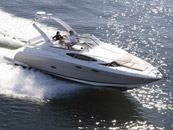Inverters provide an ideal in-between source of AC power.
By Pierce Hoover
A few months ago, I joined some friends for a coastal cruise on their vintage trawler. The weather was mild, so we anchored out most nights with the hatches open, free of machine-cooled air and the constant hum of the generator. But each morning, the skipper fired up the genset for a few minutes to power the coffee maker and microwave.
"You really should add an inverter," I told him. "Would that be better than a generator?" he asked. "It’s not a question of one or the other," I replied. "They serve different purposes."
Back at home the next week, I dug out a business card and called Don Wilson for some clarification. Wilson is a sales application engineer with Xantrex Technology, and he’s spent some 20 years working with inverters in mobile and marine applications. "Inverters excel at two things," he told me. "They are good for delivering heavy 110-volt current loads for short durations or really light loads for a long period of time."
As it turns out, there are two scenarios where firing up a generator (especially a diesel-powered genset) makes the least sense. Short starts and stops are hard on diesels, and running under a light load wastes fuel. So if you’re making a pot of coffee (high current draw, short duration) or using a lowpower, 110-volt appliance (power tool, television, laptop power supply), an inverter can save fuel plus wear and tear on the genset.
But inverters do have their limitations. "It’s not a magic power source," Wilson says. "It’s really just another way to generate power, but the fuel is your batteries." In comparison to a generator, even a large (and therefore heavier and more expensive) battery bank has a relatively limited power capacity. It would be unrealistic to expect an inverter/battery combination to power an air conditioner through the night, but it can certainly handle that morning coffee pot and microwave warm-up.
There are two basic variables involved in selecting an inverter system: power requirements and battery capacity. Both can be calculated using readily available formulas posed on various websites or provided by companies such as Xantrex. Power output from the inverter is typically rated in watts and battery capacity in amp/hours. While inexpensive, portable inverters cannot sustain peak output for prolonged periods; a good-quality, fixed-mount unit can continue to provide full-rated power for long periods and may be able to handle surge loads of twice the rated capacity for short periods.
Inverters are most effective when coupled to a bank of deepdraw batteries isolated from the starting batteries, and it’s best to plan on drawing these batteries down no more than 50 percent on a regular basis. More sophisticated inverter systems provide automatic monitoring of battery discharge and may also incorporate a recharging function that can work with shore power or the generator.
"In my opinion, you get the best bang for your buck from AMG batteries," Wilson says. "You can charge them more aggressively than gel cells, they don’t have the off-gassing issues of lead/acids and they are considerably less expensive than the hydrides."
Two common mistakes made when installing inverters is using undersize wiring to carry the 12-volt load and making that run too long. "The inverter may only be delivering 5 amps of current on the AC side," Wilson says, "but that means it’s drawing 50 amps off the DC side. Long runs and undersize wiring will create an excessive voltage drop that can shut the inverter down." For optimum performance, the wiring run from the inverter to the battery bank should be no more than 4 to 6 feet, using the wire gauge recommended by the manufacturer. Other issues to avoid during the installation process include providing adequate ventilation for the inverter, as temperatures greater than 120 degrees can create problems.
But while the inverter should not be located too far from the batteries, it shouldn’t be placed in close proximity to any type of battery that is prone to off-gassing, as these vapors can cause corrosive damage to the inverter’s internal components. Because inverters can create sparks in some situations, they should not be located in small engine spaces aboard gas-powered boats.
All inverters convert DC power into alternating current, but those known as pure sine wave inverters deliver this current in a smoother wave pattern. Most inverters provide cleaner AC power than some shore power sources, says Wilson. Devices such as heating elements and simple motors won’t require as clean a power supply and will operate quite well on a modified sine wave inverter. But if you plan to use more sensitive electronics, such as a laser printer or television, you would be well-served to upgrade to a pure sine wave system, which typically costs about 20 to 25 percent more for a given power output.
Resources:
charlesindustries.com
promariner.com
xantrex.com
Shared with permission by MotorBoating.
